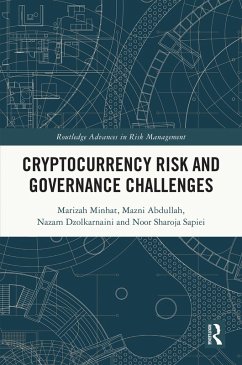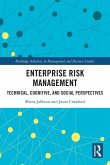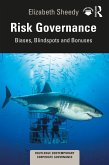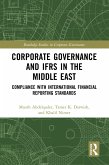Marizah Minhat, Mazni Abdullah, Nazam Dzolkarnaini, Noor Sharoja Sapiei
Cryptocurrency Risk and Governance Challenges (eBook, PDF)
42,95 €
42,95 €
inkl. MwSt.
Sofort per Download lieferbar

21 °P sammeln
42,95 €
Als Download kaufen

42,95 €
inkl. MwSt.
Sofort per Download lieferbar

21 °P sammeln
Jetzt verschenken
Alle Infos zum eBook verschenken
42,95 €
inkl. MwSt.
Sofort per Download lieferbar
Alle Infos zum eBook verschenken

21 °P sammeln
Marizah Minhat, Mazni Abdullah, Nazam Dzolkarnaini, Noor Sharoja Sapiei
Cryptocurrency Risk and Governance Challenges (eBook, PDF)
- Format: PDF
- Merkliste
- Auf die Merkliste
- Bewerten Bewerten
- Teilen
- Produkt teilen
- Produkterinnerung
- Produkterinnerung

Bitte loggen Sie sich zunächst in Ihr Kundenkonto ein oder registrieren Sie sich bei
bücher.de, um das eBook-Abo tolino select nutzen zu können.
Hier können Sie sich einloggen
Hier können Sie sich einloggen
Sie sind bereits eingeloggt. Klicken Sie auf 2. tolino select Abo, um fortzufahren.

Bitte loggen Sie sich zunächst in Ihr Kundenkonto ein oder registrieren Sie sich bei bücher.de, um das eBook-Abo tolino select nutzen zu können.
This book provides an interdisciplinary critical perspective regarding risk, uncertainty, and governance challenges of cryptocurrencies.
- Geräte: PC
- mit Kopierschutz
- eBook Hilfe
Andere Kunden interessierten sich auch für
![Cryptocurrency Risk and Governance Challenges (eBook, ePUB) Cryptocurrency Risk and Governance Challenges (eBook, ePUB)]() Marizah MinhatCryptocurrency Risk and Governance Challenges (eBook, ePUB)42,95 €
Marizah MinhatCryptocurrency Risk and Governance Challenges (eBook, ePUB)42,95 €![Risk Science (eBook, PDF) Risk Science (eBook, PDF)]() Terje AvenRisk Science (eBook, PDF)52,95 €
Terje AvenRisk Science (eBook, PDF)52,95 €![Risk Science (eBook, PDF) Risk Science (eBook, PDF)]() Terje AvenRisk Science (eBook, PDF)48,95 €
Terje AvenRisk Science (eBook, PDF)48,95 €![Enterprise Risk Management (eBook, PDF) Enterprise Risk Management (eBook, PDF)]() Mirna JabbourEnterprise Risk Management (eBook, PDF)42,95 €
Mirna JabbourEnterprise Risk Management (eBook, PDF)42,95 €![Insider Risk and Personnel Security (eBook, PDF) Insider Risk and Personnel Security (eBook, PDF)]() Paul MartinInsider Risk and Personnel Security (eBook, PDF)41,95 €
Paul MartinInsider Risk and Personnel Security (eBook, PDF)41,95 €![Risk Governance (eBook, PDF) Risk Governance (eBook, PDF)]() Elizabeth SheedyRisk Governance (eBook, PDF)44,95 €
Elizabeth SheedyRisk Governance (eBook, PDF)44,95 €![Corporate Governance and IFRS in the Middle East (eBook, PDF) Corporate Governance and IFRS in the Middle East (eBook, PDF)]() Muath AbdelqaderCorporate Governance and IFRS in the Middle East (eBook, PDF)42,95 €
Muath AbdelqaderCorporate Governance and IFRS in the Middle East (eBook, PDF)42,95 €-
-
-
This book provides an interdisciplinary critical perspective regarding risk, uncertainty, and governance challenges of cryptocurrencies.
Dieser Download kann aus rechtlichen Gründen nur mit Rechnungsadresse in A, B, BG, CY, CZ, D, DK, EW, E, FIN, F, GR, HR, H, IRL, I, LT, L, LR, M, NL, PL, P, R, S, SLO, SK ausgeliefert werden.
Produktdetails
- Produktdetails
- Verlag: Taylor & Francis eBooks
- Seitenzahl: 174
- Erscheinungstermin: 8. September 2023
- Englisch
- ISBN-13: 9781000929317
- Artikelnr.: 68451234
- Verlag: Taylor & Francis eBooks
- Seitenzahl: 174
- Erscheinungstermin: 8. September 2023
- Englisch
- ISBN-13: 9781000929317
- Artikelnr.: 68451234
- Herstellerkennzeichnung Die Herstellerinformationen sind derzeit nicht verfügbar.
Dr Marizah Minhat is an Associate Professor in Finance and Economics at the University of Bradford, United Kingdom. She founded the Responsible FinTech Research Group and taught in the MSc FinTech programme. She is a Fellow Chartered Accountant (FCA) of the Institute of Chartered Accountants in England and Wales (ICAEW), a member of ICAEW Digital Assets Working Party and Deputy Chair of ICAEW Scotland Network Board. She was also appointed as a Visiting Fellow at the London School of Economics (LSE).
Dr Mazni Abdullah is an Associate Professor at the Department of Accounting, Faculty of Business and Economics, University of Malaya, Kuala Lumpur, Malaysia. She is a Chartered Accountant (CA) of the Malaysian Institute of Accountants (MIA) and a member of the Malaysian Institute of Certified Public Accountants and the Malaysian Institute of Management. She is also a member of the Integrated Reporting Steering Committee of the MIA.
Dr Nazam Dzolkarnaini is an Associate Professor in Accounting and Finance at the University of Bradford, United Kingdom. He is a Fellow of Chartered Accountants Australia and New Zealand. He promotes public and community development in his role as a Founding Director, Chairman and Trustee of the Ethical Finance and Investment Research (EFAIR) Foundation.
Dr Noor Sharoja Sapiei is a Senior Lecturer at the Department of Accounting, Faculty of Business and Economics, University of Malaya, Kuala Lumpur, Malaysia. She is the Editor-in-Chief of the Asian Journal of Business and Accounting and an Editorial Advisory Board Member of the Asian Journal of Accounting Perspectives. She is also a member of the Taxation Practice Committee of the Malaysian Institute of Accountants (MIA).
Dr Mazni Abdullah is an Associate Professor at the Department of Accounting, Faculty of Business and Economics, University of Malaya, Kuala Lumpur, Malaysia. She is a Chartered Accountant (CA) of the Malaysian Institute of Accountants (MIA) and a member of the Malaysian Institute of Certified Public Accountants and the Malaysian Institute of Management. She is also a member of the Integrated Reporting Steering Committee of the MIA.
Dr Nazam Dzolkarnaini is an Associate Professor in Accounting and Finance at the University of Bradford, United Kingdom. He is a Fellow of Chartered Accountants Australia and New Zealand. He promotes public and community development in his role as a Founding Director, Chairman and Trustee of the Ethical Finance and Investment Research (EFAIR) Foundation.
Dr Noor Sharoja Sapiei is a Senior Lecturer at the Department of Accounting, Faculty of Business and Economics, University of Malaya, Kuala Lumpur, Malaysia. She is the Editor-in-Chief of the Asian Journal of Business and Accounting and an Editorial Advisory Board Member of the Asian Journal of Accounting Perspectives. She is also a member of the Taxation Practice Committee of the Malaysian Institute of Accountants (MIA).
Table of Contents
Cryptocurrency Risk and Governance Challenges *
Book blurb and key words *
Preface *
Acknowledgements *
List of Acronyms and Abbreviations *
List of Tables and Figures *
1. Introduction *
1.1 Financial Technology (FinTech) *
1.2 The Market for Cryptocurrencies *
1.3 Abstracts of Chapters *
2. Priority Research *
2.1 Introduction *
2.2 Research Objectives *
2.3 Research Instruments *
2.4 Survey Sample *
2.5 Interview Sample *
3 Demystifying the Nature of Cryptocurrencies *
3.1 Introduction *
3.2 Money as a Public Good *
3.3 Cryptocurrency versus Electronic Money *
3.4 Speculative Assets *
3.5 Digital Asset, Digital Currency and Digital Token as Securities *
3.6 Cryptoassets as Exchange Tokens *
3.7 Crypto-Tokens as Objects of Property Rights *
3.8 Accounting Treatment *
3.9 Summary *
4 Information Asymmetry and Knowledge-Gap Risk *
4.1 Introduction *
4.2 Fundamentals *
4.3 Awareness *
4.4 Literacy *
4.5 Education *
4.6 Summary *
5 Opaqueness and financial crime risk *
5.1 Introduction *
5.2 Opaqueness *
5.3 Financial Crime *
5.4 Enforcement *
5.5 Due Diligence *
5.6 Activism *
5.7 Summary *
6 Technology and Security Risk *
6.1 Introduction *
6.2 Blockchain *
6.3 Smart Contract *
6.4 Security and Concentration *
6.5 Summary *
7 Speculative Value and Gambling Risk *
7.1 Introduction *
7.2 Speculation *
7.3 Gambling *
7.4 COVID-19 Pandemic *
7.4.1 Data and risk measures *
7.4.2 Results *
7.5 Summary *
8 Shariah-Compliant Risk *
8.1 Introduction *
8.2 Digital Currency as Mal *
8.3 Alternative Views *
8.4 Potential Harm *
8.5 Uncertainty *
8.6 Summary *
9 Regulatory Gap *
9.1 Introduction *
9.2 Malaysia *
9.3 United Kingdom *
9.4 Summary *
10 Governance Challenges in Cyberspace *
10.1 Introduction *
10.2 Criteria for Good Regulation *
10.3 Challenges in Cyber Governance *
10.4 The Latest Debacle *
10.5 Further Research *
11 Conclusions *
11.1 Introduction *
11.2 Cryptocurrency Risk *
11.3 Governance Implications *
References *
Appendix 1 - Sample Published Opinions of Stakeholders *
Appendix 2 - Requirement for Digital Asset Custodian in Malaysia *
Appendix 3 - Additional Requirements Relating to Digital Asset Exchange (DAX) in Malaysia *
Appendix 4 *
Index *
Cryptocurrency Risk and Governance Challenges *
Book blurb and key words *
Preface *
Acknowledgements *
List of Acronyms and Abbreviations *
List of Tables and Figures *
1. Introduction *
1.1 Financial Technology (FinTech) *
1.2 The Market for Cryptocurrencies *
1.3 Abstracts of Chapters *
2. Priority Research *
2.1 Introduction *
2.2 Research Objectives *
2.3 Research Instruments *
2.4 Survey Sample *
2.5 Interview Sample *
3 Demystifying the Nature of Cryptocurrencies *
3.1 Introduction *
3.2 Money as a Public Good *
3.3 Cryptocurrency versus Electronic Money *
3.4 Speculative Assets *
3.5 Digital Asset, Digital Currency and Digital Token as Securities *
3.6 Cryptoassets as Exchange Tokens *
3.7 Crypto-Tokens as Objects of Property Rights *
3.8 Accounting Treatment *
3.9 Summary *
4 Information Asymmetry and Knowledge-Gap Risk *
4.1 Introduction *
4.2 Fundamentals *
4.3 Awareness *
4.4 Literacy *
4.5 Education *
4.6 Summary *
5 Opaqueness and financial crime risk *
5.1 Introduction *
5.2 Opaqueness *
5.3 Financial Crime *
5.4 Enforcement *
5.5 Due Diligence *
5.6 Activism *
5.7 Summary *
6 Technology and Security Risk *
6.1 Introduction *
6.2 Blockchain *
6.3 Smart Contract *
6.4 Security and Concentration *
6.5 Summary *
7 Speculative Value and Gambling Risk *
7.1 Introduction *
7.2 Speculation *
7.3 Gambling *
7.4 COVID-19 Pandemic *
7.4.1 Data and risk measures *
7.4.2 Results *
7.5 Summary *
8 Shariah-Compliant Risk *
8.1 Introduction *
8.2 Digital Currency as Mal *
8.3 Alternative Views *
8.4 Potential Harm *
8.5 Uncertainty *
8.6 Summary *
9 Regulatory Gap *
9.1 Introduction *
9.2 Malaysia *
9.3 United Kingdom *
9.4 Summary *
10 Governance Challenges in Cyberspace *
10.1 Introduction *
10.2 Criteria for Good Regulation *
10.3 Challenges in Cyber Governance *
10.4 The Latest Debacle *
10.5 Further Research *
11 Conclusions *
11.1 Introduction *
11.2 Cryptocurrency Risk *
11.3 Governance Implications *
References *
Appendix 1 - Sample Published Opinions of Stakeholders *
Appendix 2 - Requirement for Digital Asset Custodian in Malaysia *
Appendix 3 - Additional Requirements Relating to Digital Asset Exchange (DAX) in Malaysia *
Appendix 4 *
Index *
Table of Contents
Cryptocurrency Risk and Governance Challenges *
Book blurb and key words *
Preface *
Acknowledgements *
List of Acronyms and Abbreviations *
List of Tables and Figures *
1. Introduction *
1.1 Financial Technology (FinTech) *
1.2 The Market for Cryptocurrencies *
1.3 Abstracts of Chapters *
2. Priority Research *
2.1 Introduction *
2.2 Research Objectives *
2.3 Research Instruments *
2.4 Survey Sample *
2.5 Interview Sample *
3 Demystifying the Nature of Cryptocurrencies *
3.1 Introduction *
3.2 Money as a Public Good *
3.3 Cryptocurrency versus Electronic Money *
3.4 Speculative Assets *
3.5 Digital Asset, Digital Currency and Digital Token as Securities *
3.6 Cryptoassets as Exchange Tokens *
3.7 Crypto-Tokens as Objects of Property Rights *
3.8 Accounting Treatment *
3.9 Summary *
4 Information Asymmetry and Knowledge-Gap Risk *
4.1 Introduction *
4.2 Fundamentals *
4.3 Awareness *
4.4 Literacy *
4.5 Education *
4.6 Summary *
5 Opaqueness and financial crime risk *
5.1 Introduction *
5.2 Opaqueness *
5.3 Financial Crime *
5.4 Enforcement *
5.5 Due Diligence *
5.6 Activism *
5.7 Summary *
6 Technology and Security Risk *
6.1 Introduction *
6.2 Blockchain *
6.3 Smart Contract *
6.4 Security and Concentration *
6.5 Summary *
7 Speculative Value and Gambling Risk *
7.1 Introduction *
7.2 Speculation *
7.3 Gambling *
7.4 COVID-19 Pandemic *
7.4.1 Data and risk measures *
7.4.2 Results *
7.5 Summary *
8 Shariah-Compliant Risk *
8.1 Introduction *
8.2 Digital Currency as Mal *
8.3 Alternative Views *
8.4 Potential Harm *
8.5 Uncertainty *
8.6 Summary *
9 Regulatory Gap *
9.1 Introduction *
9.2 Malaysia *
9.3 United Kingdom *
9.4 Summary *
10 Governance Challenges in Cyberspace *
10.1 Introduction *
10.2 Criteria for Good Regulation *
10.3 Challenges in Cyber Governance *
10.4 The Latest Debacle *
10.5 Further Research *
11 Conclusions *
11.1 Introduction *
11.2 Cryptocurrency Risk *
11.3 Governance Implications *
References *
Appendix 1 - Sample Published Opinions of Stakeholders *
Appendix 2 - Requirement for Digital Asset Custodian in Malaysia *
Appendix 3 - Additional Requirements Relating to Digital Asset Exchange (DAX) in Malaysia *
Appendix 4 *
Index *
Cryptocurrency Risk and Governance Challenges *
Book blurb and key words *
Preface *
Acknowledgements *
List of Acronyms and Abbreviations *
List of Tables and Figures *
1. Introduction *
1.1 Financial Technology (FinTech) *
1.2 The Market for Cryptocurrencies *
1.3 Abstracts of Chapters *
2. Priority Research *
2.1 Introduction *
2.2 Research Objectives *
2.3 Research Instruments *
2.4 Survey Sample *
2.5 Interview Sample *
3 Demystifying the Nature of Cryptocurrencies *
3.1 Introduction *
3.2 Money as a Public Good *
3.3 Cryptocurrency versus Electronic Money *
3.4 Speculative Assets *
3.5 Digital Asset, Digital Currency and Digital Token as Securities *
3.6 Cryptoassets as Exchange Tokens *
3.7 Crypto-Tokens as Objects of Property Rights *
3.8 Accounting Treatment *
3.9 Summary *
4 Information Asymmetry and Knowledge-Gap Risk *
4.1 Introduction *
4.2 Fundamentals *
4.3 Awareness *
4.4 Literacy *
4.5 Education *
4.6 Summary *
5 Opaqueness and financial crime risk *
5.1 Introduction *
5.2 Opaqueness *
5.3 Financial Crime *
5.4 Enforcement *
5.5 Due Diligence *
5.6 Activism *
5.7 Summary *
6 Technology and Security Risk *
6.1 Introduction *
6.2 Blockchain *
6.3 Smart Contract *
6.4 Security and Concentration *
6.5 Summary *
7 Speculative Value and Gambling Risk *
7.1 Introduction *
7.2 Speculation *
7.3 Gambling *
7.4 COVID-19 Pandemic *
7.4.1 Data and risk measures *
7.4.2 Results *
7.5 Summary *
8 Shariah-Compliant Risk *
8.1 Introduction *
8.2 Digital Currency as Mal *
8.3 Alternative Views *
8.4 Potential Harm *
8.5 Uncertainty *
8.6 Summary *
9 Regulatory Gap *
9.1 Introduction *
9.2 Malaysia *
9.3 United Kingdom *
9.4 Summary *
10 Governance Challenges in Cyberspace *
10.1 Introduction *
10.2 Criteria for Good Regulation *
10.3 Challenges in Cyber Governance *
10.4 The Latest Debacle *
10.5 Further Research *
11 Conclusions *
11.1 Introduction *
11.2 Cryptocurrency Risk *
11.3 Governance Implications *
References *
Appendix 1 - Sample Published Opinions of Stakeholders *
Appendix 2 - Requirement for Digital Asset Custodian in Malaysia *
Appendix 3 - Additional Requirements Relating to Digital Asset Exchange (DAX) in Malaysia *
Appendix 4 *
Index *







